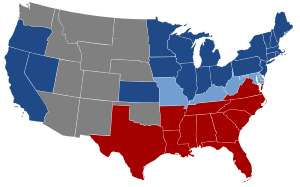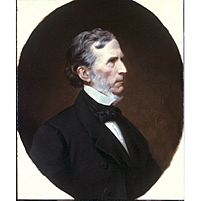United States Congressional Joint Committee on Reconstruction facts for kids
The Joint Committee on Reconstruction was a special group of lawmakers. It was also known as the Joint Committee of Fifteen because it had 15 members. This committee played a very important part in the time after the American Civil War. This period was called Reconstruction.
The committee's main job was to check on the states that had formed the Confederate States of America. These were the Southern states that had left the United States. The committee needed to decide if these states were ready to send representatives back to Congress.
This important committee also wrote the first version of the Fourteenth Amendment to the United States Constitution. This amendment is a big part of the U.S. Constitution. The committee suggested that Southern states should not be allowed back into Congress. This was until they agreed to the Fourteenth Amendment.
Other similar committees existed later. For example, the United States House Select Committee on Reconstruction worked in the House of Representatives. There was also a Senate committee called the United States Senate Select Committee on the Removal of Political Disabilities.
Forming the Committee

The Joint Committee on Reconstruction was created on December 13, 1865. Both parts of Congress, the House and the Senate, agreed to form it. Thaddeus Stevens, a Representative from Pennsylvania, first suggested the idea.
The committee had two main leaders, called co-chairmen. They were Representative Stevens and Senator William P. Fessenden from Maine.
The committee was split into four smaller groups, called subcommittees. These groups listened to people and gathered information. Each subcommittee focused on different Southern states. For example, one group looked at Tennessee. Another looked at Virginia and the Carolinas. In total, 144 people shared their stories with the committee.
Who Was on the Committee
The Joint Committee on Reconstruction had 15 members. Nine members were from the House of Representatives. Six members were from the Senate.
The House members included:
- Congressman Stevens (from Pennsylvania)
- Elihu Washburne (from Illinois)
- Justin Morrill (from Vermont)
- John A. Bingham (from Ohio)
- Roscoe Conkling (from New York)
- George Boutwell (from Massachusetts)
- Henry Blow (from Missouri)
- Henry Grider (from Kentucky)
- Andrew Jackson Rogers (from New Jersey)
The Senate members included:
- Chairman Fessenden (from Maine)
- James W. Grimes (from Iowa)
- Jacob Howard (from Michigan)
- George Henry Williams (from Oregon)
- Ira Harris (from New York)
- Reverdy Johnson (from Maryland)
Committee's Work and Report
The committee wrote down its decisions in a special journal. However, the journal did not share the secret talks or debates. After the committee finished working on the Fourteenth Amendment, some members spoke about it. Senator Howard gave a long speech explaining the committee's ideas.
The joint committee also wrote a report. This report was released after Congress had already approved the Fourteenth Amendment. The report was shared widely with the public. Twelve of the fifteen committee members signed the main report. The other three members, Johnson, Rogers, and Grider, signed a separate report. The Joint Committee on Reconstruction was not formed again in the next Congress.



